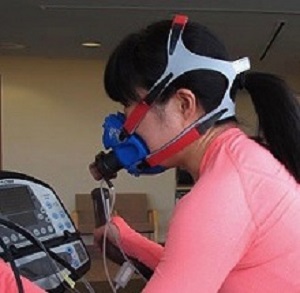 Women can process oxygen 'remarkably faster' than men when they start to exercise, according to a study from the University of Waterloo. Quick oxygen uptake places less strain on the body's cells and is considered an important measure of aerobic fitness.
Women can process oxygen 'remarkably faster' than men when they start to exercise, according to a study from the University of Waterloo. Quick oxygen uptake places less strain on the body's cells and is considered an important measure of aerobic fitness.
"The findings are contrary to the popular assumption that men's bodies are more naturally athletic," said Thomas Beltrame, lead author on the study.
The study compared oxygen uptake and muscle oxygen extraction between 18 young men and women of similar age and weight during treadmill exercise. Women consistently outperformed men with around 30% faster oxygen handling throughout the body.
"We found that women's muscles extract oxygen from the blood faster, which, scientifically speaking, indicates a superior aerobic system," said Richard Hughson, a professor in the faculty of applied health sciences, and Schlegel research chair in vascular ageing and brain health at Waterloo.
By processing oxygen faster, women are less likely to accumulate molecules linked with muscle fatigue, effort perception and poor athletic performance.
"While we don't know why women have faster oxygen uptake, this study shakes up conventional wisdom," said Beltrame. "It could change the way we approach assessment and athletic training down the road."
Abstract
Previous studies in children and older adults demonstrated faster oxygen uptake (V̇O2) kinetics in males compared with females, but young healthy adults have not been studied. We hypothesized that young men would have faster aerobic system dynamics in response to the onset of exercise than women. Interactions between oxygen supply and utilization were characterized by the dynamics of V̇O2, deoxyhemoglobin (HHb), tissue saturation index (TSI), cardiac output (Q̇), and calculated arteriovenous O2 difference (a–vO2diff) in women and men. Eighteen healthy active young women and men (9 of each sex) with similar aerobic fitness levels volunteered for this study. Participants performed an incremental cardiopulmonary treadmill exercise test and 3 moderate-intensity treadmill exercise tests (at 80% V̇O2 of gas exchange threshold). Data related to the moderate exercise were submitted to exponential data modelling to obtain parameters related to the aerobic system dynamics. The time constants of V̇O2, a–vO2diff, HHb, and TSI (30 ± 6, 29 ± 1, 16 ± 1, and 15 ± 2 s, respectively) in women were statistically (p < 0.05) faster than the time constants in men (42 ± 10, 49 ± 21, 19 ± 3, and 20 ± 4 s, respectively). Although Q̇ dynamics were not statistically different (p = 0.06) between groups, there was a trend to slower Q̇ dynamics in men corresponding with the slower V̇O2 kinetics. These results indicated that the peripheral and pulmonary oxygen extraction dynamics were remarkably faster in women. Thus, contrary to the hypothesis, V̇O2 dynamics measured at the mouth at the onset of submaximal treadmill walking were faster in women compared with men.
Authors
Thomas Beltrame, Rodrigo Villar, Richard L Hughson
[link url="https://uwaterloo.ca/news/news/women-are-naturally-more-fit-men"]University of Waterloo material[/link]
[link url="http://www.nrcresearchpress.com/doi/10.1139/apnm-2017-0097#.WiauyExuKYM"]Applied Physiology, Nutrition and Metabolism abstract[/link]
